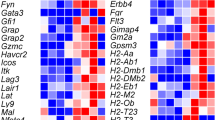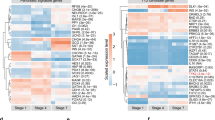Abstract
Type 1 diabetes may result from a breakdown in peripheral tolerance that is partially controlled by the expression of peripheral tissue antigens (PTAs) in lymph nodes. Here we show that the transcriptional regulator Deaf1 controls the expression of genes encoding PTAs in the pancreatic lymph nodes (PLNs). The expression of canonical Deaf1 was lower, whereas that of an alternatively spliced variant was higher, during the onset of destructive insulitis in the PLNs of nonobese diabetic (NOD) mice. We identified an equivalent variant Deaf1 isoform in the PLNs of patients with type 1 diabetes. Both the NOD mouse and human Deaf1 variant isoforms suppressed PTA expression by inhibiting the transcriptional activity of canonical Deaf1. Lower PTA expression resulting from the alternative splicing of DEAF1 may contribute to the pathogenesis of type 1 diabetes.
This is a preview of subscription content, access via your institution
Access options
Subscribe to this journal
Receive 12 print issues and online access
$209.00 per year
only $17.42 per issue
Buy this article
- Purchase on Springer Link
- Instant access to full article PDF
Prices may be subject to local taxes which are calculated during checkout







Similar content being viewed by others
References
Anderson, M.S. et al. Projection of an immunological self shadow within the thymus by the aire protein. Science 298, 1395–1401 (2002).
Lee, J.W. et al. Peripheral antigen display by lymph node stroma promotes T cell tolerance to intestinal self. Nat. Immunol. 8, 181–190 (2007).
Gardner, J.M. et al. Deletional tolerance mediated by extrathymic Aire-expressing cells. Science 321, 843–847 (2008).
Nichols, L.A. et al. Deletional self-tolerance to a melanocyte/melanoma antigen derived from tyrosinase is mediated by a radio-resistant cell in peripheral and mesenteric lymph nodes. J. Immunol. 179, 993–1003 (2007).
Kodama, K. et al. Tissue- and age-specific changes in gene expression during disease induction and progression in NOD mice. Clin. Immunol. 129, 195–201 (2008).
Lemonde, S. et al. Impaired repression at a 5-hydroxytryptamine 1A receptor gene polymorphism associated with major depression and suicide. J. Neurosci. 23, 8788–8799 (2003).
Adorini, L., Gregori, S. & Harrison, L.C. Understanding autoimmune diabetes: insights from mouse models. Trends Mol. Med. 8, 31–38 (2002).
Huggenvik, J.I. et al. Characterization of a nuclear deformed epidermal autoregulatory factor-1 (DEAF-1)-related (NUDR) transcriptional regulator protein. Mol. Endocrinol. 12, 1619–1639 (1998).
Koh, A.S. et al. Aire employs a histone-binding module to mediate immunological tolerance, linking chromatin regulation with organ-specific autoimmunity. Proc. Natl. Acad. Sci. USA 105, 15878–15883 (2008).
Org, T. et al. The autoimmune regulator PHD finger binds to non-methylated histone H3K4 to activate gene expression. EMBO Rep. 9, 370–376 (2008).
Jensik, P.J., Huggenvik, J.I. & Collard, M.W. Identification of a nuclear export signal and protein interaction domains in deformed epidermal autoregulatory factor-1 (DEAF-1). J. Biol. Chem. 279, 32692–32699 (2004).
Bottomley, M.J. et al. The SAND domain structure defines a novel DNA-binding fold in transcriptional regulation. Nat. Struct. Biol. 8, 626–633 (2001).
Czesak, M., Lemonde, S., Peterson, E.A., Rogaeva, A. & Albert, P.R. Cell-specific repressor or enhancer activities of Deaf-1 at a serotonin 1A receptor gene polymorphism. J. Neurosci. 26, 1864–1871 (2006).
Lambe, T. et al. Limited peripheral T cell anergy predisposes to retinal autoimmunity. J. Immunol. 178, 4276–4283 (2007).
Bennett, S.T. et al. Susceptibility to human type 1 diabetes at IDDM2 is determined by tandem repeat variation at the insulin gene minisatellite locus. Nat. Genet. 9, 284–292 (1995).
Egwuagu, C.E., Charukamnoetkanok, P. & Gery, I. Thymic expression of autoantigens correlates with resistance to autoimmune disease. J. Immunol. 159, 3109–3112 (1997).
Avichezer, D. et al. An immunologically privileged retinal antigen elicits tolerance: major role for central selection mechanisms. J. Exp. Med. 198, 1665–1676 (2003).
Venanzi, E.S., Melamed, R., Mathis, D. & Benoist, C. The variable immunological self: genetic variation and nongenetic noise in Aire-regulated transcription. Proc. Natl. Acad. Sci. USA 105, 15860–15865 (2008).
Gavanescu, I., Kessler, B., Ploegh, H., Benoist, C. & Mathis, D. Loss of Aire-dependent thymic expression of a peripheral tissue antigen renders it a target of autoimmunity. Proc. Natl. Acad. Sci. USA 104, 4583–4587 (2007).
Hahm, K. et al. Defective neural tube closure and anteroposterior patterning in mice lacking the LIM protein LMO4 or its interacting partner Deaf-1. Mol. Cell. Biol. 24, 2074–2082 (2004).
Derbinski, J. et al. Promiscuous gene expression in thymic epithelial cells is regulated at multiple levels. J. Exp. Med. 202, 33–45 (2005).
Derbinski, J., Schulte, A., Kyewski, B. & Klein, L. Promiscuous gene expression in medullary thymic epithelial cells mirrors the peripheral self. Nat. Immunol. 2, 1032–1039 (2001).
Planas, R. et al. Reg (regenerating) gene overexpression in islets from non-obese diabetic mice with accelerated diabetes: role of IFNβ. Diabetologia 49, 2379–2387 (2006).
Kasai, M., Kropshofer, H., Vogt, A.B., Kominami, E. & Mizuochi, T. CLIP-derived self peptides bound to MHC class II molecules of medullary thymic epithelial cells differ from those of cortical thymic epithelial cells in their diversity, length, and C-terminal processing. Eur. J. Immunol. 30, 3542–3551 (2000).
Lynch, K.W. Consequences of regulated pre-mRNA splicing in the immune system. Nat. Rev. Immunol. 4, 931–940 (2004).
Eissa, N.T. et al. Alternative splicing of human inducible nitric-oxide synthase mRNA. tissue-specific regulation and induction by cytokines. J. Biol. Chem. 271, 27184–27187 (1996).
Gratchev, A. et al. Alternatively activated macrophages differentially express fibronectin and its splice variants and the extracellular matrix protein βIG-H3. Scand. J. Immunol. 53, 386–392 (2001).
Borsi, L., Castellani, P., Risso, A.M., Leprini, A. & Zardi, L. Transforming growth factor-beta regulates the splicing pattern of fibronectin messenger RNA precursor. FEBS Lett. 261, 175–178 (1990).
Togo, S., Shimokawa, T., Fukuchi, Y. & Ra, C. Alternative splicing of myeloid IgA Fc receptor (FcαR, CD89) transcripts in inflammatory responses. FEBS Lett. 535, 205–209 (2003).
Cowling, R.T. et al. Effects of cytokine treatment on angiotensin II type 1A receptor transcription and splicing in rat cardiac fibroblasts. Am. J. Physiol. Heart Circ. Physiol. 289, H1176–H1183 (2005).
Creusot, R.J. et al. Tissue-targeted therapy of autoimmune diabetes using dendritic cells transduced to express IL-4 in NOD mice. Clin. Immunol. 127, 176–187 (2008).
Acknowledgements
We thank H. Iwai and C. Taylor for technical assistance; J. Visvader (The Walter and Eliza Hall Institute of Medical Research) for Deaf1-deficient mice; and the Network for Pancreatic Organ Donors with Diabetes (Juvenile Diabetes Research Foundation) and the National Disease Research Interchange for human PLNs and spleen samples. Supported by the US National Institutes of Health (U01 DK078123-03, U19-DK 61934 and U19-AI050864 to C.G.F.), the Canadian Institutes of Health Research (P.R.A. and M.C.) and the American Diabetes Association (L.Y.).
Author information
Authors and Affiliations
Contributions
L.Y. did microarray and quantitative PCR assays, cloned full-length DF1-VAR1 and Hu-DF1-VAR, synthesized DF1-VAR1, Hu-DF1 and Hu-DF1-VAR, did subcellular localization and siRNA experiments, assessed Deaf1-deficient mice for lymphocyte infiltration and serum autoantibodies, prepared the manuscript and composed the figures; R.J.C. extracted tissues for microarray and quantitative PCR, isolated cellular subsets from PLNs and, with P.C., isolated and immortalized the CD45− cells; D.S. cloned the DF1 isoform and synthesized DF1 fusion proteins; M.A. (and the Network for Pancreatic Organ Donors with Diabetes) provided human PLNs and spleen samples; M.C. and P.R.A. provided the Deaf1-deficient mice and provided guidance on work with these mice; A.-R.C. and S.J.T. provided expertise and guidance on the isolation of the CD45− lymph node stromal elements; L.S. did the immunoblot, coimmunoprecipitation and luciferase reporter assays and, with C.G.F., R.J.C. and L.Y., was involved in all aspects of the planning and direction of this work; all authors reviewed and edited the manuscript; and C.G.F. provided most of the funding.
Corresponding author
Supplementary information
Supplementary Text and Figures
Supplementary Figures 1–7 and Supplementary Tables 1–4 (PDF 2441 kb)
Rights and permissions
About this article
Cite this article
Yip, L., Su, L., Sheng, D. et al. Deaf1 isoforms control the expression of genes encoding peripheral tissue antigens in the pancreatic lymph nodes during type 1 diabetes. Nat Immunol 10, 1026–1033 (2009). https://doi.org/10.1038/ni.1773
Received:
Accepted:
Published:
Issue Date:
DOI: https://doi.org/10.1038/ni.1773
This article is cited by
-
The aging of the immune system and its implications for transplantation
GeroScience (2023)
-
Zinc finger myeloid Nervy DEAF-1 type (ZMYND) domain containing proteins exert molecular interactions to implicate in carcinogenesis
Discover Oncology (2022)
-
Lymph node stromal cells: cartographers of the immune system
Nature Immunology (2020)
-
Tissue-Engineered Stromal Reticula to Study Lymph Node Fibroblastic Reticular Cells in Type I Diabetes
Cellular and Molecular Bioengineering (2020)
-
Phenotypic alterations in pancreatic lymph node stromal cells from human donors with type 1 diabetes and NOD mice
Diabetologia (2019)



